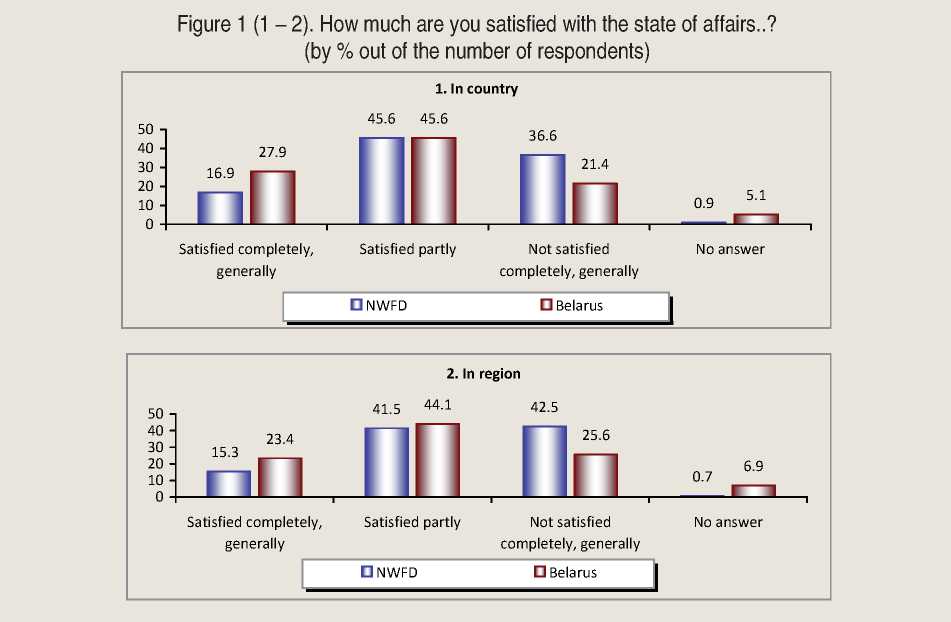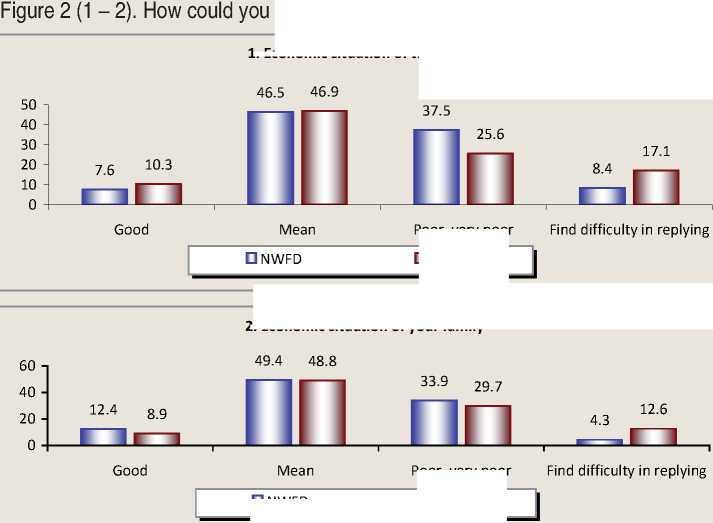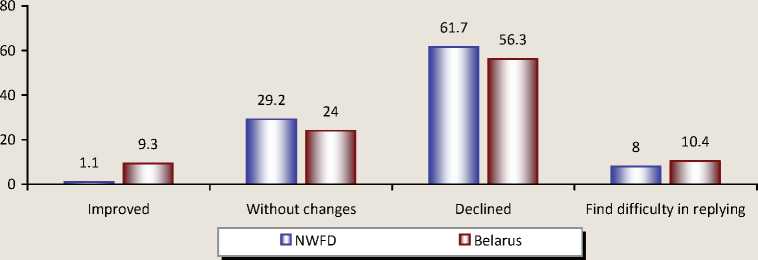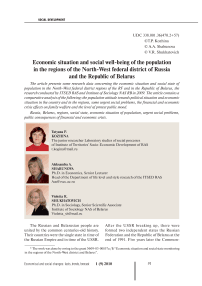Economic situation and social well-being of the population in the regions of the North-West federal district of Russia and the Republic of Belarus
Автор: Kozhina Tatyana Pavlovna, Shabunova Aleksandra Anatolevna, Shukhatovich Violetta Ruslanovna
Журнал: Economic and Social Changes: Facts, Trends, Forecast @volnc-esc-en
Рубрика: Social development
Статья в выпуске: 1 (9) т.3, 2010 года.
Бесплатный доступ
The article presents some research data concerning the economic situation and social state of population in the North-West federal district regions of the RF and in the Republic of Belarus, the research conducted by ITSED RAS and Institute of Sociology NAS RB in 2009. The article contains a comparative analysis of the following: the population attitude towards political situation and economic situation in the country and in the regions, some urgent social problems, the financial and economic crisis effects on family welfare and the level of protest public mood.
Russia, belarus, regions, social state, economic situation of population, urgent social problems, public consequences of financial and economic crisis
Короткий адрес: https://sciup.org/147223179
IDR: 147223179 | УДК: 338.001.36(470.2+57),
Текст научной статьи Economic situation and social well-being of the population in the regions of the North-West federal district of Russia and the Republic of Belarus
The Russian and Belarusian people are united by the common centuries-old history. Their countries were the single state in time of the Russian Empire and in time of the USSR.
After the USSR breaking up, there were formed two independent states the Russian Federation and the Republic of Belarus at the end of 1991. Five years later the Common-
* The work was done by owing to the grant №09-03-00857а /Б “Economic situation and social state monitoring in the regions of the North-West district and Belarus”.
wealth of Belarus and Russia was organized in order to unite some humanitarian, economic and military spaces. Later (in 2000) the close integration in the political, economical and social spheres led to the formation of allied state of Russia and Belarus – a confedera-tive union of the Russian Federation and the Republic of Belarus, the common political, economical, military, customs, currency, legal, humanitarian and culture space being organized step-by-step.
Being constantly developed, the cooperation at the regional level plays a significant part in the development of trade and economic relations between Belarus and Russia. While in 1990s The Republic of Belarus has stable economic ties only with several Russia’s regions (Moscow, Krasnodar Territory, Moscow region, Tyumen region and Volgograd region), during the first decade of the 21st century 80 Russian regions including all regions of the NWFD set their hand on the treaties and protocols in the trade and economic field, in the field of science, education and culture.
The post-Soviet period is characterized by certain distinctions. So, according to the experts’ evaluations, in Belarus there was not so large-scale privatization as in Russia, but state enterprises were being commercialized gradually. The Belorussian government tried to retain control over the large-scale business and to follow a policy of paternalism towards the population. As a result of that, on the one hand, there was no any really efficient economy developed, and, on the other hand, the population didn’t experience so “shock therapy” as it was in Russia. Belarus seeks to maintain many economic contacts with the Russian enterprises, having an economic self-sufficiency and its own tax system available. The country managed to keep its considerable industrial export to Russia over the whole transition period. Thanks to cheap Russian raw material Belarus could afford not to run the hazard connected with its development, retaining its social and economic stability. Belarus didn’t even experience the 1998 – 1999 economic recession, and after the year of 2000 it has steady upturn that shifted into low gear only because of the world economic depression. In Russia the social and political things and events as well as the consequences of the world financial and economic crisis had more pronounced social aftereffects.
The North-West district of the RF is close to the Republic of Belarus (Pskov region borders on the country, the stretch of border is 305 km), and it made for the traditions of their close cooperation in the social and economic and cultural fields. The common past, the similarity of social and cultural traditions including the verbal community are the occasions of such interaction too. After all both the ties of relationship and friendship between peoples continue.
From the standpoint of the post-Soviet development features it is interesting and useful to research the influence of modern social and economic and political processes in these different countries on the material welfare, standard and quality of life and public mood. This information can be received by social measuring.
Studying the dynamics of population’s social perception of social and economic and political processes, ITSED RAS has been polling the population in 10 regions of the North-West federal district of Russia since 2005. In 2009 in April and May the research was being conducted in parallel with the Republic of Belarus thanks to the cooperation with the Institute of Sociology NASB1 and with the support of RHSF, the similar methods used.
In 2009 the population of Belorussian was 9671.9 thousand people, the NWFD – 13462.3 thousand people. There are 10 regions in the
1 The number of respondents was 5,100 people in 9 regions of the NWFD (500 people in every region) and 1,500 people in Vologda region. In Belarus – 2,068 people. Sample representativeness is provided by keeping the proportions between urban and rural population, the proportions between people living in different kinds of populated areas (rural communities, small and middle towns; age-sex structure of adult population.
Survey method – domiciliaryquestionnaire poll of the respondents. Sampling error isn’t more than 3%.
NWFD, while there are 7 regions in the Republic of Belarus (fig. 1) . The largest regions are the city of Saint Petersburg (4581.8 thousand people) and the city of Minsk (1829.1 thousand people).
Estimating their attitude to the state of affairs in the country, both parts often take up the neutral stance – “satisfied partly” (each country – 46%; figure 1). At the same time the NWFD has greater negative opinions (37% as against 21%), and Belarus – positive ones (respectively 28 and 17%). The situation in home region is estimated in a more critical way: the share of negative opinions reaches 43% in the NWFD and 26% in Belarus.
The circumstances satisfaction is connected with perception of those life challenges which the citizens of both countries have to encounter in the post-Soviet period of development. A number of the most acute problems has clarified itself, they are urgent for both Russia and Belarus (i.e. they are in the top ten on both parts; tab. 1). They are the following: inflation, low standard of life, unemployment, poor affordable housing, abrupt splitting of population by income, growth of alcoholism and corrupt practice. At the same time there are some clear-cut distinctions between the problems significance for both nations. So, in Belarus the primary problem is alcoholization (62%), with the problem of inflation being moved a little (61%).
The main personal problems of both nations are similar in many respects. The inflation takes first place. In spite of that it is more acute for the inhabitants of the Russia’s North-West (55%) than for those of Belarus (39%). About every third or fourth is worried about low standard of life and poor affordable housing. More than one fourth of the NWFD population and every fifth in Belarus marks poor quality of public health service.
In the whole Byelorussians consider the state problems more urgent, while the people of the Russia’s North-West regions take the personal and family problems more urgent.
In the light of the factors of social splitting which is taken as an urgent problem of our modern life by 23% people of the NWFD and

Table 1. The most acute problems of modern life (by % out of the number of respondents)
|
Problem |
NWFD |
Belarus |
|
At the state level |
||
|
Inflation (continuously rising prices) |
54.7 (1) |
61.0 (2) |
|
Low standard of life |
47.5 (2) |
48.4 (3) |
|
Unemployment |
43.3 (3) |
40.5 (6) |
|
Economy disintegration, stoppage of enterprises |
28.0 (4) |
27.7 (12) |
|
Poor affordable housing |
27.2 (5) |
41.9 (4) |
|
Civic insecurity |
24.2 (6) |
31.1 (11) |
|
Abrupt splitting of population by income |
23.3 (7) |
40.0 (7) |
|
Growth of alcoholism |
22.4 (8) |
62.3 (1) |
|
High level of crime |
22.2 (9) |
27.4 (14) |
|
Corruption, bribery |
21.1 (10) |
37.9 (10) |
|
At the personal and family level |
||
|
Inflation (continuously rising prices) |
55.3 (1) |
38.6 (1) |
|
Low standard of life |
34.8 (2) |
30.1 (2) |
|
Poor affordable housing |
33.6 (3) |
23.5 (3) |
|
Poor quality of public health service |
29.1 (4) |
20.7 (4) |
|
Unemployment |
26.1 (5) |
9.5 (10) |
|
Civic insecurity |
23.3 (6) |
14.6 (5) |
|
Poor environmental conditions |
21.5 (7) |
12.8 (6) |
|
Economy disintegration, stoppage of enterprises |
13.9 (8) |
5.8 (14) |
|
Abrupt splitting of population by income |
12.4 (9) |
10.8 (7) |
|
Arrears in payment |
11.4 (10) |
10.0 (9) |
40% population of Belarus, it is important to find out what social stratum (by income, occupation, social esteem, way of life) they are connected themselves with in the place of their dwelling and in the country in the whole. It turned out that nearly equal groups of both nations believe themselves to be a member of the stratum above the middle one: 7 – 9% in their town (settlement) and 4 – 5% in country (tab. 2) . Meanwhile in spite of the fact that the NWFD population has less acute sense of social splitting as a state problem they point out their belonging to the stratum below the middle one more often than Belarusians (34% as against 24% in their populated area and 46% as against 33% in their country). It is also worth paying attention to the considerably large share of “lower class” representatives in the NWFD – as much as 1.8 – 1.9 times. So “the middle class” is represented here to a lesser degree: 46% as against 57% in town / settlement and 32% as against 45% in country.
In Belarus the part of rural population is higher (31% as against 24% in the NWFD), and the splitting processes are feebly marked among country people. This fact probably had an influence on the nature of opinions. Moreover approximately every fifth – sixth from each parts finds it difficult to correlate himself with some kind of social stratum.
The parts of people who consider themselves to be a member of the stratum above the middle one in the place of their residence are correlated with the share of those who give a positive assessment of their family welfare: respectively 7 – 8% and 9 – 12% ( see table 2; fig. 2) . We can observe higher level of negative assessments given by the NWFD population versus more frequent vague answers given by Belarusians.
The economic situation of the country being evaluated, the shares of locutionary assessments are also the same (in 47% each), and the negative аassessments in the NWFD are as frequent as 1.5 times (38% as against 26%).
The positive assessment of the family material welfare makes it possible to give rather high assessment to the income purchasing power:
Table 2. What social stratum do you rate yourself? (by % out of the number of respondents)
|
Social stratum |
NWFD |
Belarus |
||||||
|
In town (village) |
In country |
In town (village) |
In country |
|||||
|
Upper class |
1.8 |
7.9 |
1.2 |
4.6 |
1.3 |
6.7 |
0.8 |
3.7 |
|
Above middle class |
6.1 |
3.4 |
5.4 |
2.9 |
||||
|
Middle class |
46.1 |
31.8 |
57.4 |
44.7 |
||||
|
Below middle class |
24.9 |
33.7 |
30.5 |
46.4 |
18.8 |
23.7 |
24.4 |
32.8 |
|
Lower class |
8.8 |
15.9 |
4.9 |
8.4 |
||||
|
Find difficulty in replying |
12.3 |
17.2 |
12.2 |
18.8 |
||||
1. Economic situation of the country evaluate …? (by % out of the number of respondents)

Poor, very poor
□ NWFD
□ Belarus
Poor, very poor
□ Belarus
2. Economic situation of your family
approximately a tenth of population from both parts are rated to these categories. However the people more often mention that they are able to buy only the necessary food and clothes but they have a difficult time to buy a large purchase (in 43% each). The part of people with low income purchasing power in the North-West regions reaches 40% (as against 34%). Meanwhile, in Belarus the refusal rate is more (15% as against 8%).
There observed some certain correlations between the income purchasing power assessment and people’s determination of their belonging to one or another class. So, the share of “poor”, “needy” (in the NWFD – 41%, in Belarus – 30%) is comparable to the share of those who “has enough money for food at the best” (40 and 34%). People of “average income” who are share and share alike (in 49% each) probably reckon themselves among those whose income permits them to purchase needed goods and the part of these people cannot afford themselves to buy a car. Probably the people of both countries associate the concept of “average income” rather with the opportunity to satisfy their daily wants than with their well-being.
The important factor defining the social state of population is nature of forecasts connected with the prospects of private welfare development and state development in the whole. In this respect the pessimistic expectations are prevalent in the NWFD (50 – 56%; fig. 3 ), and the vague ones – in
Belarus (46 – 47%). Nevertheless the part of those who hopes for a situation improvement is higher in the NWFD – 21 – 22% as against 17 – 18%. In Belarus the expectations of private welfare development almost coincide with the prospective development direction of the country’s economy. At the same time the population of the NWFD admits the possibility of negative development of situation in the country (56%) more often than in the family (50%).
The prevalence of negative forecasts about the family welfare development is fixed in the processes of on-going world financial crisis; in this connection it is important to study how and to what extent the consequences of crisis have been reflected in the life of people. The monitoring results showed that the population of Russia’s North-West suffered from the crisis more than Belarusians (tab. 3) . They were influenced greatly by inflation (84% as against 76%), reduction (45% as against 33%) and delay (32% as against 16%) of wage and social benefits. They noticed also more severe effects of crisis such as staff cuts (25% as against 9%) and plant shutdown (13 and 4%) much more often.
The majority of population from both parts noticed declining of their material situation as a result of crisis, but more often – in the NWFD (62% as against 56%; fig. 4 ). Besides that almost every tenth in Belarus observed some positive changes, while in Russia there is hardly such category (1%).
In crisis the population’s assessments concerning the readiness to accept the existing situation assume great importance. The level of “stock of patience” (i.e. the share of persons who marked “all is not so bad and one can live”, “it’ difficult to live, but one can endure”) in both categories under review are almost the same (76 – 78%; fig. 5 ). At the same time the category of those who is not ready to endure distress any longer made up 14% as against 8% in the NWFD. Although in the North-West regions the group of population who estimated the economic condition of their family as “very poor” (11%) was more than in Belarus (6%).
More frequent position – “it’s impossible to endure our distress any longer” – in the NWFD (14% as against 8%), as well as pessimistic sentiments about the next changes in the economic condition of family (50% as against 36% in
Figure 3 (1 – 2). What is expected in the economic situation of the country / your family in your opinion? (by % out of the number of respondents)
1. Economic situation of the country

Improving of situation Deterioration of situation Find difficulty in replying
□ NWFD ' □ Belarus I

Table 3. The share of people in region who and whose family felt the consequences of crisis (by % out of the number of respondents)
|
Consequences |
NWFD |
Belarus |
|
Increase in prices for consumer goods and services |
84.4 |
76.4 |
|
Reduction (cutback) in wage and social benefits |
44.5 |
33.3 |
|
Depreciation of ruble savings |
27.9 |
30.6 |
|
Delay of wage and social benefits |
31.5 |
16.2 |
|
Staff cuts, layoff in an enterprise |
25.2 |
9.1 |
|
Plant shutdown, pause |
13.2 |
4.2 |
Figure 4. Do you think that your (your family) economic condition becomes better, worse or doesn’t change as a result of crisis? (by % out of the number of respondents)

Figure 5. Which of the given statements agrees with the existing situation? (by % out of the number of respondents)

□ NWFD □ Belarus
Belarus) explain the situation when the people of Russia’s North-West much more often let in the possibility of mass protest actions and the potentiality of their personal participation. (as more often as 5 times; fig. 6 ).
The social and economic development of the country depends directly on the efficiency of the state and public institutions operating and on the level of population’s confidence in them. The international comparison assumes great importance in this respect. The similarity of positions of both nations is shown in almost the same level of confidence in the first official of the state and it’s much higher than to other structures (63 – 65%; tab. 4). However in the whole Byelorussians are notable for the greater degree of confidence in state authority institutions: form 47 to 43% of population trust in militia, judicial bodies, security services, Council of Ministers of the Republic of Belarus, local
Figure 6. The share of population letting in the possibility of mass protest actions against the increase in prices and low standard of life in the place of residence and the potentiality of their personal participation (by % out of the number of respondents)

Table 4. Level of confidence in existing state and public institutions in country (by % out of the number of respondents)
Both nations trust in mass media and social and political structures least of all. So 28% of the NWFD population (the 5th place) and 30% of Belarusians (the 8th place) trust in media, 25 – 26% – in trade unions (the 8th – 9th places), 13 – 15% – in political parties (the 10th place).
Thus, the research has shown that the people of Russia’s North-West and the Republic of Belarus often trouble about the same problems – inflation, low standard of life, unaffordable housing, quality of public health service. At the same time the economic and political situation in the country as well as the level of private welfare are more frequently estimated neutrally. About half of population from both parts feels that they are people of average income. Meanwhile the negative assessments in almost all items are given more often by the population of Russia’s North-West. Accordingly the specific weight of those for whom “it’s impossible to endure our distress any longer” and who express the potentiality of their participation in protest actions. In crisis many people of the NWFD and Belarus are ready to seek for additional sources of income. However as opposed to Belarusians the people of Russian north-western regions more seldom show the readiness to save but they more often find difficulty in describing their possible actions or refuse to do something. Both nations are inclined to trust in the head of state, but the Belarusian level of confidence in other authorities is much higher.
The joint research of people’s social sentiments in the NWFD regions and the Republic of Belarus helps to understand the situation from the standpoint of population who live in the respective territories and to modify their steps for further development. We consider that such work is useful not only for scientific search but also for use of its results in the practical activity of state and local authorities. The next stages of research will show the direction of situation development. The nearest stage will take place in 2010.
Список литературы Economic situation and social well-being of the population in the regions of the North-West federal district of Russia and the Republic of Belarus
- Belarus in figures: statistical reference-book. -Minsk, 2009.
- Federal service of state statistics . -Access mode: http://www.gks.ru
- Social and economic indicators of the CIS countries . -Access mode: http://belstat.gov.by/homep/ru/indicators/doclad/aug/pril/9.pdf
- Grigor’ev L. Belorussia: oil “tiger” in Europe/L. Grigor’ev, S. Agibalov . -Access mode: http://www.vedomosti.ru/newspaper/article.shtml?2007/01/11/118680


